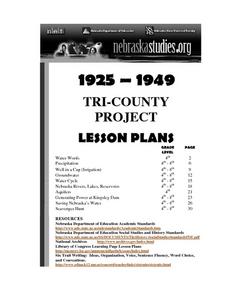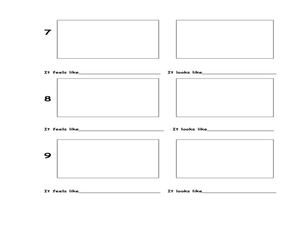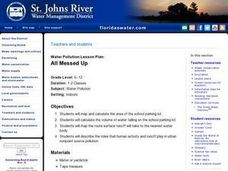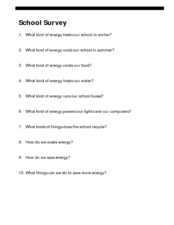Curated OER
"Tri-County" Project--Well in a Cup
Students construct a model of a well to identify how water is brought to the surface. Signs of pollution are investigated.
Curated OER
What's Gotten Into You?
Young scholars use models to investigate the process and consequences of water contamination on the land, groundwater, and plants.
Curated OER
Would You Drink This?
Students examine how they affect water quality of those who live downstream after identifying rivers and river basins in Kansas.
Curated OER
Investigate Factors Affecting Nitrates in Groundwater
Pupils participate in an experiment in which they investigate the factors affecting the levels of nitrates in groundwater. Using examples, they explain the nitrogen cycle and identify the sources of chemical nitrogen fertilizers. They...
Curated OER
Wat-er We Good For?
Fifth graders investigate the use of water as a resource that needs to be conserved. They practice the skill of water conservation by taking a home survey of water usage and modify the use in order to decrease the wasting of water.
Curated OER
Build an Exhibit
Eighth graders discover the importance of keeping the water in the water supply clean. Using the internet, they complete an activity in which they record their answers on a worksheet. In groups, they create their own exhibit on...
Curated OER
Pollution Solutions
Young scholars participate in a hands-on activity to determine how water is polluted and investigate steps in how to treat water. Students try to produce the cleanest water possible using the materials provided.
Curated OER
Tree Bagging
High schoolers bag trees to determine the mass of the water given off in the evapotranspiration process.
Curated OER
Photos from the Past
Pupils observe and interpret historic photographs of water in New Mexico. They record observations, draw inferences, and compare water in New Mexico's past with water today. They create a class book or exhibition of the photographs with...
Curated OER
Exploring Marine Objects
Learners identify the sources of water on Earth. In this life science lesson, students list the different plants and animals that live in the ocean. They explore marine objects in the lab and draw them.
Curated OER
All Messed Up
Young scholars begin the experiment by mapping and calculating their school parking lot. They calculate the volume of water falling on the lot and map the route the water runoff takes. They discuss the roles that humans play in affecting...
Curated OER
Power In Variety
Learners discover different types of energy. In this energy source lesson students compare different types of energy, renewable and nonrenewable. Learners answer questions about the different types of energy and their impact on the...
Curated OER
Photos from the Past-Grades 5-8
Students examine and interpret historic photographs of water use in New Mexico. They match captions to the pictures as to what they think the picture depicts. They research a topic represented by their photograph and write an extended...
Curated OER
Volume of Irregular Objects
Fifth graders experiment using a Meniscus. In this volume lesson, 5th graders identify the volume of irregular objects using the process of water displacement. Students record data and draw conclusions.
Curated OER
Fossil Fuel and the Ticking Clock
Learners study energy sources to learn about fossil fuels and environmental concerns. In this energy sources lesson, students watch demonstrations for various energy examples. Learners find hidden pennies, make a bar graph on their data,...
Curated OER
Solar Matters
Students design an energy resource wheel and demonstrate how to use it to access information about renewable and nonrenewable energy sources.
Curated OER
The Great Volume Exchanger...or the Magic Matter Maker ®
Students pour water into a "magic" box and examine how it comes out with a much larger volume of water. They, working in small groups, design a volume exchanger and explain its design to the whole class.
Curated OER
Language Arts: Investigating Issues That Matter
Students are able to become more informed about the dangers of water contamination by sharing their prior knowledge with each other. They discover the importance of communicating these dangers to the public.
Curated OER
Kansas River: Where Do They Come From? Where Do They Flow? Which Ones Make the Kansas River Grow?
Students identify major rivers in Kansas, identify the direction which they flow and identify tributaries of the Kansas River. Students examine what occurrences upstream influence water quality downstream.
Curated OER
School Survey
In this school energy worksheet, students read the questions about school's energy sources, the way school's can recycle, and how energy can be wasted or saved in schools.
Curated OER
A SALT WATER-Y WORLD
High schoolers observe a model of the distribution of the earth's water and compare the relative volumes and percentages of types of water on earth.
Curated OER
Mapping your watershed
Learners investigate the importance of watersheds around the world. By visiting resource links, students can locate watersheds and their sources in the USA and Russia and analyze their effects on the surrounding topography. This lesson...
Curated OER
Hot Stuff
Students investigate if heat can change the form of matter. In this physics instructional activity, students use heat sources to observe the changes in an ice cube. Students graph which heat source changed the matter the fastest.
Curated OER
science: Light Up the Ocean
students investigate light levels under the ocean by conducting several simulations. After creating solutions representing seawater, they shine a light sensor on it to discover how light diffuses and is absorbed by the impurities in the...
Other popular searches
- Sources of Water Pollution
- Water Sources Grades K 2
- Water Sources K 2
- Activities on Water Sources
- Natural Water Sources
- Water Sources in Qatar
- Types of Water Sources
- Landforms Water Sources
- Sources of Water
- Streams as Water Sources
- Natural Sources of Water
- Water Sources in Drought

























